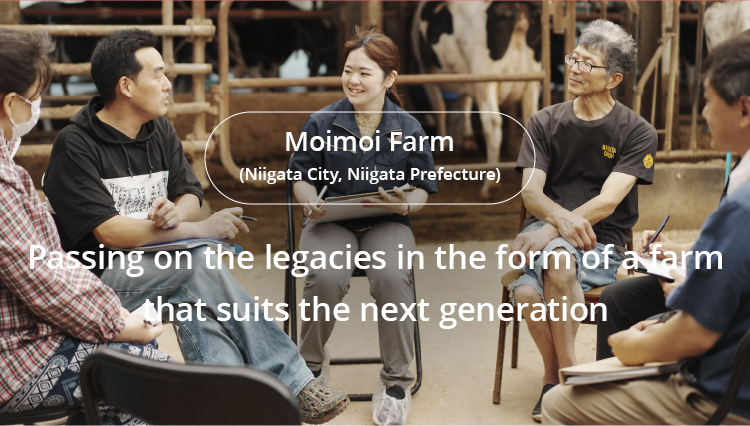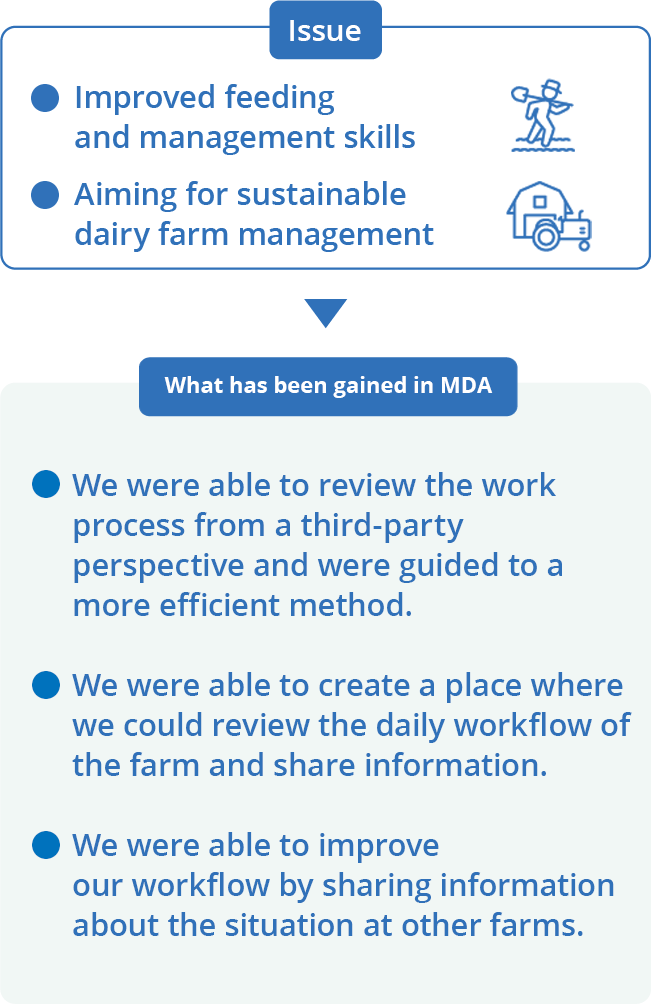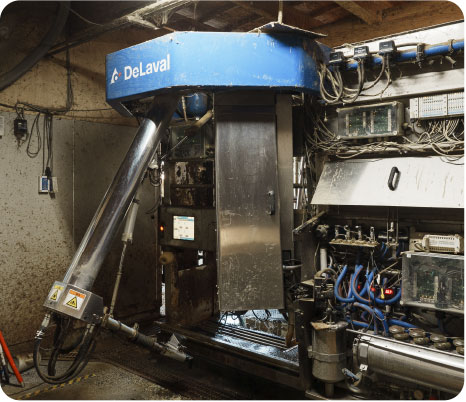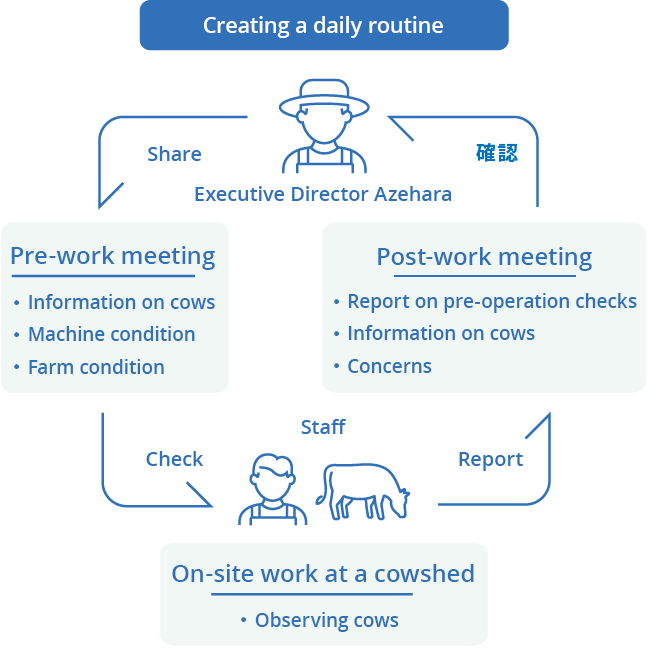

For dairy farmers, the succession is a source of concern.
Moimoi Farm is promoting third-party succession through the efforts of Meiji Dairy Advisory (MDA).
We spoke to Mr. Fujito Tsutsumi, the president, and Mr. Kenta Azehara, the executive director about the difficulties of dairy farming and the optimal timing for business succession.
-


Fujiito Tsutsumi


Kenta Azehara
-


The transition from incorporation to third-party succession to stabilize management
The predecessor of Moimoi Farm is one of the five dairy farms started at the same time in the former Ajikata Village in Niigata Prefecture, Tsutsumi Farm. More than 40 years ago, President Tsutsumi took over his father's business and started dairy farming. After several decades, the successors of the neighboring dairy farms were absent or the owners themselves passed away at a young age, leaving President Tsutsumi as the last one.
We realized that we needed to increase the number of cows we raise to sustainably operate our five cowsheds. Therefore, we incorporated our business and named it Moimoi Farm. This name comes from the Finnish word "Moi," which means "Hi (Hey!)" and sounds like the mooing of cow.
For Moimoi Farm, which faced challenges in securing successors, a major benefit of incorporation was that anyone could become a successor. President Tsutsumi, who believes that "Any job goes better when done by someone who loves it," was willing to entrust the farm to anyone who had the desire to do dairy farming, regardless of whether they were from a dairy farming family or not.
That is when Mr. Azehara, the executive director, appeared. "I wanted to work with livestock. I was planning to train here and take over my family's dairy farm, but my family went out of business and I had no place to go back to," he said. Then President Tsutsumi asked Mr. Azehara if he would eventually take over Moimoi Farm.
However, at that time, Moimoi Farm had a small number of cows and problems with work efficiency, which made the management unstable and threatened to go bankrupt. Therefore, they decided to increase the number of cows they raised and introduce milking robots, aiming to improve the efficiency of their operations.
Currently, President Tsutsumi, Executive Director Azehara, one employee, and three part-time workers produce about two tons of raw milk daily.
President Tsutsumi, who had introduced milking robots to improve productivity, but felt that he had to stabilize the farm management more before he could hand it over to Executive Director Azehara, decided to adopt MDA.
President Tsutsumi says, "I was initially facing a plateau in the management of my farm, so I decided to join MDA to enhance my farm management skills to the next level."
Although the farm management level at that time was slightly above average, we realized that it was insufficient to sustain dairy farming in the future.
-


Nine years ago, DeLaval robotic milking machines were introduced.
-


Besides robotic milking, pipeline milkers and parlors are utilized according to the style of the cowshed.
The goal of their management is "to reduce the number of cows that are not suitable for milking." Normally, the average number of births that a cow gives in her lifetime on a farm is said to be two or three, but at Moimoi Farm, some cows give birth to seven or eight.
By reducing the number of cows that fall ill during their lifetime, we can naturally increase their lifetime milk production.
"When there are many cows that get sick, I want to be able to notice and respond quickly. If I fail to do so, I feel my inadequacy in detecting any abnormalities, and I want to develop my observation skills so that I can stand on my own without relying on President Tsutsumi," says Executive Director Azehara. Improving the farm management level to achieve a timely succession is an urgent challenge.
Reviewing work processes and sharing information has increased our productivity.
Through our MDA initiative, we have conducted a review of the work processes on the farms from a third-party perspective, and provided guidance on "KAIZEN," which means continuous improvement on the work, as well as re-examining the management policies for business succession.
"The work that I thought was normal here, the MDA team members suggest things like ‘Can we change it this way to make it more efficient?’ or ‘This is the work process at other farms,’ so I am very grateful for their help." says Mr. Azehara.
Among them, reviewing their daily routine has greatly helped to improve the quality of the milk. "We didn’t have a place to share information before. We talked about the cows’ condition and the machines’ performance while working, but we inevitably missed some things. Now we have meetings before and after work, share information and take notes, and then start work. This has reduced the number of work errors," says Mr. Azehara.
Currently, the only dairy farm in the Ajikata district of Niigata Prefecture is Moimoi Farm.
Mr. Azehara hopes to create "connections" through MDA.
"Dairy farmers need to pay attention to their connections with the local community, as they have issues with manure, bedding, and odor to the surrounding area. There are no dairy farmers in this area, so I hope MDA will become a place where we can share information with dairy farmers in other areas," said Mr. Azehara.
Moimoi Farm launched an innovative project in 2022, utilizing rice whole-crop silage (rice fermented roughage), a domestic and locally sourced feed.
Niigata Prefecture is renowned for its rice cultivation.
Moimoi Farm uses rice husks from neighboring farms as bedding, but we have not been able to secure enough quantity throughout the year.
We envision to create a circular agriculture system by drawing on other examples.
"Our management philosophy is ‘Creating value for society, sowing seeds for the future.’ I believe we are now beginning to see this vision taking shape. This aspiration remains unchanged, and I will entrust it to the next generation of Azehara," President Tsutsumi says.
Moimoi Farm is gradually developing a form of agriculture that allows the life cycle of cows to circulate within the farm and collaborate with the local community.
"Eventually, we want to revitalize the region with something that uses Niigata’s fruits and vegetables and milk," says Executive Director Azehara.
Succession is a major challenge for dairy farmers, but there is also a future that opens by adopting a third-party succession model.










